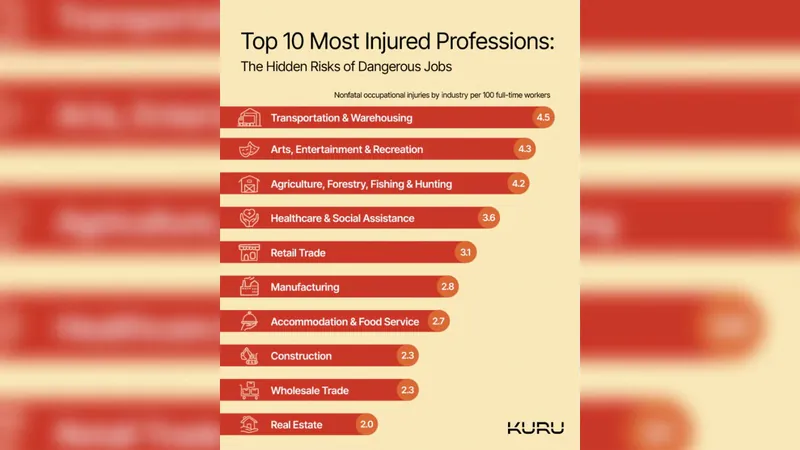
Revealed: The Most Injury-Prone Industries of 2025
2025-09-18
Author: Yu
Unveiling the Risks of 2025's Most Dangerous Jobs
In a startling revelation from Kuru's recent report, the transportation and warehousing sector takes the crown as the most injury-prone industry of 2025, boasting a staggering injury rate of 4.5 incidents per 100 workers. Following closely is the arts, entertainment, and recreation industry, which comes in at 4.3.
The Dangerous Nature of Transportation and Warehousing
Why is transportation and warehousing so hazardous? Workers in this sector are responsible for moving people and goods, managing warehouses, and supporting transportation logistics—all while facing long hours, heavy machinery, and unpredictable conditions that lead to frequent accidents.
A Close Second: Arts, Entertainment, and Recreation
The entertainment industry, encompassing everything from thrilling amusement parks to high-stakes physical performances, ranks as the second most dangerous field. The sheer physicality and sometimes unexpected hazards involved contribute to an injury rate of 4.3.
Agriculture: A Tough but Risky Business
The agriculture, forestry, fishing, and hunting sector also faces significant dangers, with an injury rate of 4.2. This field involves hard labor in often unpredictable environments, whether it’s planting crops or herding livestock, demanding ongoing safety measures.
Healthcare Heroes at Risk
Surprisingly, the healthcare and social assistance industry ranks fourth, with an alarming incidence rate of 3.6 injuries. Despite being critical for societal health, this sector saw the highest total number of work injuries in 2023, proving that even caregivers are not immune to the dangers of their professions.
Retail: Not Just a Casual Job
Retail trade, encompassing both brick-and-mortar and online stores, features prominently in the danger zone with a 3.1 injury rate. The physical demands of stocking and handling goods lead to frequent injuries, marking it as one of the top risks in employment.
Manufacturing: A Heavyweight Hazard
In manufacturing, where workers transform materials into products through mechanical and chemical processes, an injury rate of 2.8 reveals the inherent risks involved in operating machinery and dealing with often dangerous materials.
Accommodation and Food Services Under Pressure
Offering food and lodging services, this sector has an injury rate of 2.7. The demands of the job, coupled with fast-paced environments, make it crucial for workers in this industry to prioritize safety.
Construction: Heights of Danger
Known for its high physical demands, the construction industry sees an injury rate of 2.3. Working with heavy machinery and at significant heights puts workers at constant risk, making safety measures essential.
Wholesale Trade: A Hidden Danger
With the same injury rate of 2.3 as construction, wholesale trade also illustrates the risks of physically demanding work, showing that injuries occur even in less obvious high-risk professions.
Real Estate: The Silent Risk
Finally, rounding off the list is the real estate and rental/leasing industry with a 2.0 injury rate. Despite its reputation as a less physically strenuous job, the unique challenges within this sector contribute to its place among the top 10 most dangerous jobs.
Understanding the Data Behind the Risks
This analysis stems from the latest Bureau of Labour Statistics data, providing a comprehensive overview of nonfatal injuries per sector. It emphasizes the pressing need for safety initiatives across these high-risk industries.



 Brasil (PT)
Brasil (PT)
 Canada (EN)
Canada (EN)
 Chile (ES)
Chile (ES)
 Česko (CS)
Česko (CS)
 대한민국 (KO)
대한민국 (KO)
 España (ES)
España (ES)
 France (FR)
France (FR)
 Hong Kong (EN)
Hong Kong (EN)
 Italia (IT)
Italia (IT)
 日本 (JA)
日本 (JA)
 Magyarország (HU)
Magyarország (HU)
 Norge (NO)
Norge (NO)
 Polska (PL)
Polska (PL)
 Schweiz (DE)
Schweiz (DE)
 Singapore (EN)
Singapore (EN)
 Sverige (SV)
Sverige (SV)
 Suomi (FI)
Suomi (FI)
 Türkiye (TR)
Türkiye (TR)
 الإمارات العربية المتحدة (AR)
الإمارات العربية المتحدة (AR)